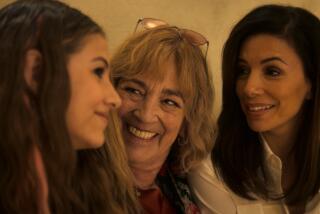A Spanish Accent
- Share via
The Movie: “Belle Epoque.”
The Setup: In the spring of 1931, a young Spanish soldier (Jorge Sanz, pictured) deserts the army and befriends a painter and his beautiful daughters; he becomes sexually entangled with all four women. A Spanish movie directed by Fernando Trueba, “Belle Epoque” is an Oscar nominee for best foreign film.
The Costume Designer: Lala Huete, who has designed costumes for several films and television series in Spain.
Quoted: “When he imagined the film, Fernando (Trueba) talked a lot about Renoir’s ‘A Day in the Country,’ Huete said. “That was the concept--the fresh air, the joy, the movement, the sexuality, the light. I used that freedom to move through different time periods with the clothes. All the film is about that--freedom.”
The Look: Fans of vintage clothing will soak up the wispy, drop-waist floral dresses; handsome silk blouses with unusual collars and buttons, and elaborately embroidered hand-me-down wedding gowns. Each sister--Clara (Miriam Diaz-Aroca), Luz (Penelope Cruz, pictured), Rocio (Maribel Verdu) and Violeta (Ariadna Gil)--is as best-dressed as the next.
Huete evokes a pastoral yet modern style by breaking rules and freely borrowing ideas and shapes from the ‘20s through the ‘30s. Although most countrywomen of the time dressed strictly in dark colors, the sisters wear yummy pastels, and their hemlines wander from just below the knee to mid-calf. Violeta is the most fashion forward in her wide trousers and menswear-inspired shirts. As Huete pointed out, “At that time, only maybe five women in the country wore trousers and they were either painters or intellectuals.”
Hit: The myriad varieties of satin bras, culottes and nightgowns--not the frilly sort, but simple and luxuriant.
Details: The Spanish twist on fashion is unmistakable in heaps of espadrilles (worn while frolicking through the country), lace mantillas and wedding veils, and handmade crocheted sweaters and dresses.
Inspiration: Photos of Spain’s early “intellectual” and sports women of the time, fashion magazines such as Vogue and Blanco y Negro, paintings by Jose Gutierrez Solana.
Sources: The sisters’ clothing, lingerie and accessories were either newly designed or purchased from antique shops in Madrid, London and Paris. Espadrilles were custom-made in Madrid.
More to Read
Only good movies
Get the Indie Focus newsletter, Mark Olsen's weekly guide to the world of cinema.
You may occasionally receive promotional content from the Los Angeles Times.









